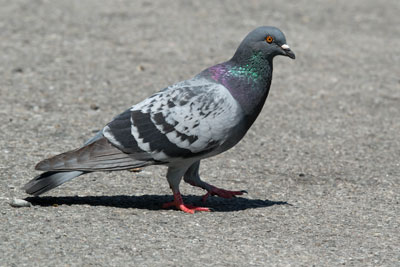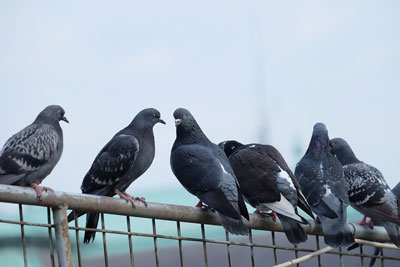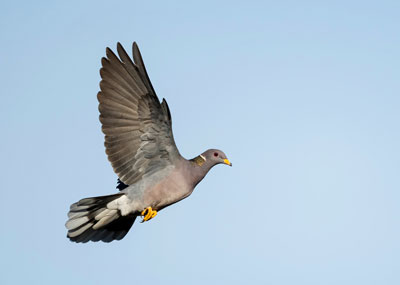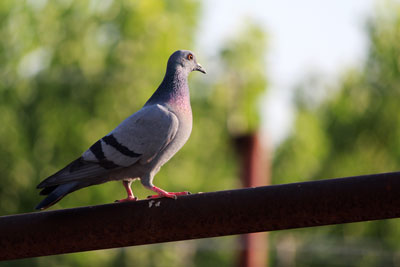




Pigeons or European rock doves, originally from Europe, Asia, and Africa, have spread throughout the world including the United States. They were originally domesticated in Europe and brought to the U.S. where they eventually escaped to the wild. Consequently, pigeons are not a native wildlife species and are not protected in Montana. Pigeons may be taken at anytime, and their nests and eggs destroyed. The spread of pigeons has been most noticeable in urban areas where they have become a nuisance.
Pigeons are primarily grain and seed eaters, have multiple broods during the year, and are long lived. Their prolific reproductive rate and gregarious nature soon leads to excessive numbers, which further compounds the damage and nuisance level. Pigeons carry diseases communicable to man, wildlife, and domestic animals and their nesting and roosting areas are dirty. Their droppings will damage the paint on vehicles and kill ornamental plants and grass. Diseases transmitted by pigeons include aspergillosis, avian tuberculosis, coccidiosis, cryptococcoses, encephalitis, histoplasmosis, Newcastle disease, salmonellosis, thrush, toxoplasmosis, and West Nile virus.
Pigeons commonly roost and nest in rafters, lofts, towers, steeples, attics, under eaves, window sills, ledges, or roof lines. In the long run, the most cost-effective method to eliminate pigeons from roosting and nesting areas is to block their access with wood, metal, masonry, glass, or to screen them out with at least ¾″ mesh wire. Destruction of nests and eggs every two-weeks during the nesting season has also been effective in reducing pigeon numbers. Roosting on open ledges, window sills, and roof lines can be discouraged or eliminated by using sharp spiked wire such as " porcupine wire." This is a costly but very effective method. Less expensive methods for discouraging roosting on ledges may include wire or net coverings, electric wire devices, or using wood or shingles to increase the angle of the roost.
There are several chemical repellents that can be easily applied to roosting areas. These are usually a tactile repellent or sticky substance that is spread on the roosting area, which has a tacky surface the birds don't like. These are available under a number of trade names, and they can be obtained through many garden supplies or feed stores.
Pigeons readily enter and are easy to trap, especially on roof tops or ledges where they congregate. There are a number of funnel and bob-type traps on the market. These traps can be purchased through hardware, garden supply, or feed stores. These types of traps catch pigeons alive by having a door that lets the pigeons easily enter the trap but not exit. For trap design and construction, see Prevention and Control of Wildlife Damage online at Internet Center for Wildlife Damage Management. If the traps are kept baited, more and more pigeons will continue to enter the traps and you will commonly catch many birds at one time. Continue the trapping until you have eliminated all of the pigeons in the area.
Devices such as decoy owls, rubber snakes, or balloons are effective for only a short period of time, and noise making devices also have very little effect on pigeons. Good old fashioned harassment by spraying with water or throwing things can be effective if you are persistent until birds have moved, but it is also time consuming.
In rural areas, shooting can be effective in removing, harassing and discouraging pigeons from using an area. It is illegal and unsafe to discharge firearms within many cities, but it may be legal if done with air rifles or pellet guns. Check your local ordinances and decide if it would be not only legal but safe within your area.
Several different chemicals have been developed and are designated for pigeon control. These are often chemically treated grain bait and are specifically labeled for pigeons. However, they should only be used by certified or licensed pesticide operators. These are poisons that are potentially harmful to people and pets, are dangerous to other birds and can create many other problems. Consequently, we do not recommend chemical control or poisons for most situations.
Controlling Nuisance:Pigeons. University of Missouri Extension Service and Missouri Conservation Commission. Columbia, MO.
Feral Pigeons. 1995. R.F. Johnston and M. Janiga. Oxford: Oxford University Press.
Prevention and Control of Wildlife Damage. 1994. Cooperative Extension Division. Institute of Agriculture and Natural Resources. University of Nebraska, Lincoln, NE. Also on-line at: http://icwdm.org.
Wildlife Damage Management. Controlling Feral Pigeons. 1998. Texas Wildlife Damage Management Service, San Antonio, TX.
Wild Neighbors The Humane Approach to Living with Wildlife. 1997. John Hadidian, Guy Hodge and John Grandy, eds. The Humane Society of the United States. Washington, D.C.
Brochure (PDF)
